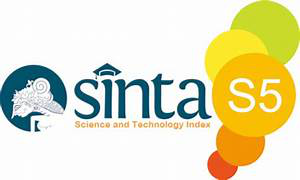REPRESENTASI SISI KEMISKINAN DALAM FILM PARASITE (ANALISIS SEMIOTIKA CHARLES SANDERS PEIRCE)
Abstract
Parasite (Korean: Gisaengchung) is a South Korean movie directed by Bong Joon-Ho. This movie, which is presented in 2019, is a dark humor film genre filled with tense scenes and dramas. Themes of social problems or problems that occur in South Korean society, namely poverty, are also presented in this movie. This research aims to analyze the poverty of a thriller drama movie. The meaning of poverty can be observed from several scenes through the relationship between signs and semiotic meanings using Charles Sanders Peirce's model with the concept of a triangle of meaning, namely sign, object and interpretant. Qualitative research in the form of Charles Sanders Peirce's semiotic analysis is used as a method in this research. Five of the entire scenes of the movie are selected as representations of poverty. The five scenes are analyzed through the relation of signs, objects and interpretant depicted in each scene. There are signs and meanings which describe poverty in several scenes in accordance with the type of poverty, namely relative poverty. The results of this study concluded that there are several scenes that represent poverty which is categorized into relative poverty as seen from the aspect of social inequality. This is because there are several characters who can make ends meet their minimum basic needs but they are still far lower than their surrounding society.
Keywords
References
Badan Pengembangan dan Pembinaan Bahasa. 2011. Kamus bahasa indonesia untuk pelajar. Jakarta: Meity Taqdir Qodratilah.
Bungin, B. 2010. Metodologi penelitian kualtitatif. Jakarta: Kencana Prenada Media Group.
Eriyanto. 2001. Analisis wacana: Pengantar analisis teks media. Yogyakarta: LKiS.
Himawan, P. 2008. Memahami film. Yogyakarta: Homerian Pustaka.
Moleong. 2003. Metode penelitian kualitatif. Bandung: PT. Remaja Rosdakarya.
Ngalimun. 2016. Strategi dan model pembelajaran. Yogyakarta: Aswaja Pessindo.
Ngalimun. 2017. Ilmu komunikasi sebuah pengantar praktis. Yogyakarta: Pustaka Baru Press.
Prasetya, B.A. 2019. Analisis semiotika film dan komunikasi. Malang: PT. Cita Intrans Selaras (Citila).
Romli, K. 2016. Komunikasi massa. Jakarta: PT Grasindo.
Sobur, A. 2006. Semiotika komunikasi. Bandung: PT Remaja Yosdakarya.
Soekanto, S. 2014. Sosiologi suatu pengatar (46th ed.). Jakarta: PT. RajaGrafindo Persada.
Sugiyono. 2016. Metodologi penelitian kuantitatif, kualitatif, dan R&D. Bandung: Alfabeta.
Vera, N. 2014. Semiotika dalam riset komunikasi. Bogor: Ghalia Indonesia.
Sumber lain:
Award for Parasite (2020, 25 Juli). Wikipedia: https://en.wikipedia.org/wiki/Parasite_(2019_film)
CNN Indonesia (2020, 25 Juni). Sinopsis ‘Parasite Film Korea Pemenang Cannes 2019. CNN Indonesia: https://www.cnnIndonesia.com/hiburan/20190625171317-220-406322/sinopsis-Parasite-film-Korea-pemenang-cannes-2019.
Internet Movie Database (2020, 21 Juni) Parasite. Internet Movie Database: https://www.imdb.com/title/tt6751668/.
Universitas Sumatera Selatan
(2020, 05 Juli)
http://repository.usu.ac.id/bitstream/handle/123456789/32341/Chapter%20II.pdf;jsessionid=7D464B21FF87DC199A7CCEA0F59A24A9?sequence=4.
DOI: 10.33751/jpsik.v5i2.4436
Refbacks
- There are currently no refbacks.

This work is licensed under a Creative Commons Attribution-ShareAlike 4.0 International License.












